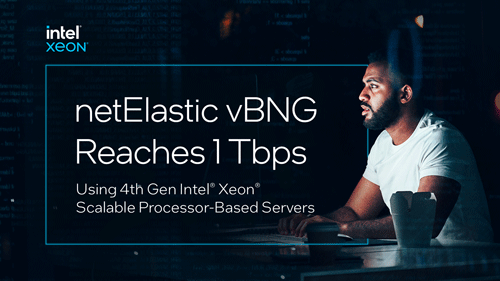Nielsen’s Law of Internet Bandwidth states that a high-end user’s connection speed grows by 50% per year. In looking at data from 1983 to 2023, it’s remarkable how closely the actual data fits the 50% annualized growth stated by Nielsen’s law. Even with minor yearly variations, Nielsen’s Law of Internet Bandwidth has held true throughout a 40-year period. This doesn’t necessarily mean that it will continue to be true for the next several decades, but it’s certainly likely.
What does this mean for broadband network planning? It means a greater emphasis on network scalability, flexibility, and agility.
Virtualization and Nielsen’s Law of Internet Bandwidth
Software-based (or virtual) networks are designed for greater scalability and flexibility. This makes them ideal to deliver future-proof bandwidth speeds and capacities. And when service providers begin to virtualize their networks, one of the first network functions they look to virtualize are broadband network gateways (BNGs).
Virtual broadband network gateways (vBNGs) establish and manage sessions between subscriber devices and the service provider’s network, and then out to the internet. vBNGs also provide authentication, authorization, and accounting (AAA) services, as well as enforcing policies to ensure quality of service.
The Importance of vBNGs in Broadband Network Performance
vBNGs play a crucial role in ensuring optimal network performance. They act as a bridge between the service provider’s network and the subscriber’s devices, facilitating seamless connectivity and delivering high-speed internet services. And the performance of vBNG directly impacts overall network efficiency and the end-user experience.
A high performance vBNG can ensure low-latency, high-speed internet services, and efficient resource utilization. On the other hand, poor performance can lead to network congestion, service degradation, and dissatisfied customers.
One of the key aspects of vBNG’s role in network performance is its ability to efficiently manage subscriber sessions. With the increasing number of connected devices and the growing demand for bandwidth-intensive applications, vBNG plays a critical role in ensuring smooth and uninterrupted connectivity for end-users. By establishing and managing sessions between subscriber devices and the provider’s network, vBNG enables broadband providers to allocate resources effectively and prioritize traffic based on predefined policies.
Joining Forces to Drive vBNG Performance

Given the importance of high-performing vBNGs, Intel and netElastic have been working together to raise the bar on vBNG performance. In recent tests conducted by Intel, netElastic vBNG reached 1 Terabit of throughput on a 2 RU server powered by 4th Gen Intel Xeon Scalable processors (hotlink to white paper). This is a new level of performance for vBNGs.
While not all service providers may need 1 Terabit of throughput today, given Nielsen’s Law of Internet Bandwidth, the bandwidth demands of tomorrow may require all of that capacity in the future. Intel’s recent tests prove that at these Terabit performance levels, netElastic vBNG should be considered when maximum performance and scalability are needed.
Next Steps
To learn more about how your broadband network can benefit from high performance vBNGs, please attend the netElastic and Intel webinar on “netElastic vBNG Enables Terabit Speed Broadband Networks,” which will take place on July 25th at 8:00am PDT (USA). In this webinar, we’ll discuss:
- The Changing World of Broadband Service Providers
- Software-based Routers
- New Levels of vBNG Performance with netElastic and Intel
- Real World (Service Provider) Examples
If you have any questions before the webinar, please free to contact us here.

